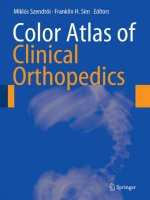color atlas of histopathology of the cervix uteri 2nd ed - c. dallenbach - hellweg, et al., (springer, 2006)
Bạn đang xem bản rút gọn của tài liệu. Xem và tải ngay bản đầy đủ của tài liệu tại đây (33.08 MB, 206 trang )
Gisela Dallenbach-Hellweg
Magnus von Knebel Doeberitz
Marcus J.Trunk
Color Atlas of Histopathology of the Cervix Uteri
Gisela Dallenbach-Hellweg
Magnus von Knebel Doeberitz
Marcus J.Trunk
Color Atlas of
Histopathology
of the Cervix Uteri
Second Edition
With 239 Figures and 4 Tables
Library of Congress Control Number: 2005926890
ISBN-10 3-540-25188-X Springer Berlin Heidelberg New York
ISBN-13 978-3-540-25188-0 Springer Berlin Heidelberg New York
1st Edition ISBN-10 3-540-52295-6 Springer Berlin Heidelberg New York
This work is subject to copyright. All rights are reserved, whether the whole or part of the material is
concerned, specifically the rights of translation, reprinting, reuse of illustrations, recitation, broad-
casting, reproduction on microfilm or in any other way, and storage in data banks. Duplication of this
publication or parts thereof is permitted only under the provisions of the German Copyright Law of
September 9, 1965, in its current version, and permission for use must always be obtained from
Springer. Violations are liable to prosecution under the German Copyright Law.
Springer is a part of Springer Science+Business Media
springeronline.com
© Springer-Verlag Berlin Heidelberg 2006
Printed in Germany
The use of general descriptive names, registered names, trademarks, etc. in this publication does not
imply, even in the absence of a specific statement, that such names are exempt from the relevant
protective laws and regulations and therefore free for general use.
Product liability: the publishers cannot guarantee the accuracy of any information about dosage and
application contained in this book. In every individual case the user must check such information by
consulting the relevant literature.
Editor: Gabriele Schröder, Heidelberg, Germany
Desk Editor: Ellen Blasig, Heidelberg, Germany
Production: ProEdit GmbH, 69126 Heidelberg, Germany
Cover: Frido Steinen-Broo, EStudio Calamar, Spain
Typesetting: K. Detzner, 67346 Speyer, Germany
Printed on acid-free paper 24/3151 ML 5 4 3 2 1 0
Professor Dr.med.
Gisela Dallenbach-Hellweg
Private address:
Ludolf-Krehl-Strasse 57
D-69120 Heidelbeg
Tel. +49 -6221-471461
Professor Dr.med.
Magnus von Knebel Doeberitz
Institute of Molecular Pathology
University of Heidelberg
Im Neuenheimer Feld 220
D-69120 Heidelberg
Email: &
Dr. med. Marcus J.Trunk
Head of Pathology
MTM Laboratories AG
Im Neuenheimer Feld 583
D-69120 Heidelberg
Email:
The new edition of this atlas integrates all significant advances made in the past 15 years
in molecular pathology, tumor virology, and genetics of cervical cancer. It emphasizes
the importance of these advances in facilitating its pathological diagnosis and in opti-
mizing clinical management and prognosis. A new chapter on immunohistochemistry
has been added, which includes refined detection methods, e.g., the overexpression of
p16
INK4a
as a molecular marker in the early differential diagnosis of premalignant le-
sions. The section on etiology and pathogenesis in human papillomavirus-induced
neoplasia has been incorporated to represent new insights into the sequences of cellu-
lar and nuclear deregulation at the molecular level.All chapters have been revised to in-
clude the newest advances and relevant experiences in how to interpret and manage
cervical disease; they are supported by the addition of 35 new microphotographic illus-
trations. The tumor nomenclature is adapted to the latest edition of the WHO classifi-
cation; the morphology code of the international classification of diseases for oncology
(ICD-O) has been added. We have also updated the list of references by adding recent
relevant publications.
Again, the staff of Springer-Verlag deserve our thanks for their patience and skill in
preparing the manuscript and in reproducing the microphotographs.
Heidelberg, February 2005
Gisela Dallenbach-Hellweg,
Magnus von Knebel Doeberitz,
and Marcus J.Trunk
Heading2
Preface to the Second Edition
Heading2
Preface to the First Edition
During the past decade our understanding of the histopathology of the cervix uteri has
changed greatly. Because of the lifestyles of the modern permissive society, cervical vi-
ral infections have become epidemic, resulting in inflammatory and precancerous le-
sions that were uncommon but now are seen mainly in the younger age groups with in-
creasing frequency. Then too, progress in molecular biology and immunohistochemis-
try has enabled us to distinguish subtypes of papilloma viruses, to proceed in under-
standing their action within the genome, and to trace the infected metaplastic and neo-
plastic-transformed cells to their histogenetic origins. The resultant refined classifica-
tion of cervical neoplasias has helped to predict clinical outcome and to choose type of
therapy.
This atlas is intended for all pathologists, to aid them in their routine diagnostic
work. We hope it explains just how comprehensive, important and complex the histop-
athology of the cervix uteri has become during the last few years. It covers all pertinent
differential diagnostic aspects and describes in detail how to reach the correct diagno-
sis. The atlas is also meant for the clinician, to guide him in his often difficult decision
of how to provide optimal care for the frequently young patient, who desires children
but is at risk for cancer. In particular, the atlas is designed to foster an improved dia-
logue between the pathologist and the clinician.
The microphotographs were selected from our daily diagnostic material, since they
show best the technical variations confronting the clinical pathologist in his daily rou-
tine, where effects of specimen transport, differences in tissue fixation, and variations
in embedding and staining often compound his diagnostic problems. The various
shades of haematoxylin-eosin stains shown by our photographs reflect the differences
we have experienced with our material as it comes in daily or is received as referral cas-
es from clinics and institutes. We have not attempted to eliminate the deficiencies of
these specimens, since the pathologist using this atlas is entitled to find realistic photo-
graphs rather than idealistic ones.We want him to recognize a lesion irrespective of the
quality of fixation or intensity of staining.
We express our gratitude to Prof. Dr. Frederick D. Dallenbach for the subtle English
translation.We also extend our thanks to the staff of Springer-Verlag for their patience,
generosity, and skill in preparing the manuscript and in reproducing our microphoto-
graphs.
We find ourselves in an exciting period of molecular biology, during which rapid de-
velopments in diagnostic techniques and concepts are clarifying relationships between
molecular changes and the pathogenesis of cervical cancer. As is to be expected, some
of our statements will be short-lived, forced aside as new facts and information emerge
to replace them. In contrast, other statements we have made may grow in importance.
May both the controversial issues and those being accepted with ever-increasing favour
contribute to make this atlas a source of stimulus to encourage lively discussions and re-
warding ideas.
Mannheim and Copenhagen, July 1990
Gisela Dallenbach-Hellweg
and Hemming Poulsen
Preface of the First Edition
VIII
Screening for Cervical Cancer Precursors
to Prevent Invasive Disease
. . . . . . . . . . . . . . . . . . . . . . . . . . 1
Methods of Obtaining and Preparing Cervical Tissue
for Histological Examination
. . . . . . . . . . . . . . . . . . . . . . . . . 2
Diagnostic or Therapeutic Procedures ...................... 2
Colposcopically Directed (Punch) Biopsy................... 2
Cold Knife Conization . . . . . . . . . . . . . . . . . . . . . . . . . . . . . 2
Loop Electrosurgical Excision Procedure . . . . . . . . . . . . . . . . . . . 4
Endocervical Curettage . . . . . . . . . . . . . . . . . . . . . . . . . . . . 4
Simple Hysterectomy.............................. 5
Preparation of the Cervical Specimen ...................... 5
Immunohistochemistry and In Situ Hybridization
. . . . . . . . . . . . 7
Immunohistochemistry ............................. 7
Reasons for Use . . . . . . . . . . . . . . . . . . . . . . . . . . . . . . . . 8
Cervical Tumor Cell Differentiation . . . . . . . . . . . . . . . . . . . . . . 8
Distinction of Squamous, Glandular and Neuroendocrine Lesions . . . . . 8
CIN versus Reactive/Atrophic Epithelia . . . . . . . . . . . . . . . . . . . 9
Adenocarcinoma In Situ versus Mimics . . . . . . . . . . . . . . . . . . . 10
Endocervical Lesions versus Upper Genital Tract Lesions . . . . . . . . . 11
In Situ Hybridization ............................... 11
Normal Histology, Regeneration, and Repair
. . . . . . . . . . . . . . . 13
Normal Ectocervix ................................ 13
Ascending Repair ................................. 18
Normal Endocervix ................................ 20
Descending Repair ................................ 24
Transformation Zone ............................... 29
Heading2
Contents
X
Contents
Vestigial and Heterotopic Tissues
. . . . . . . . . . . . . . . . . . . . . . 32
Mesonephric Duct Remnants and Hyperplasia ................. 32
Müllerian Duct Remnants and Metaplasia .................... 34
Heterotopic Ectodermal and Mesodermal Structures .............. 39
Hormonally Induced Changes
. . . . . . . . . . . . . . . . . . . . . . . . 42
Effects of Estrogen ................................ 42
Parakeratosis and Hyperkeratosis of the Ectocervix . . . . . . . . . . . . . . 42
Cystic Hyperplasia of the Endocervix . . . . . . . . . . . . . . . . . . . . . 42
Effects of Endogenous Progesterone under Hypersecretion ........... 46
Glandular and Cystic Hyperplasia of the Endocervix . . . . . . . . . . . . . 46
Effects of Exogenous Gestagens ......................... 49
Glandular (Adenomatous) Hyperplasia of the Endocervix . . . . . . . . . . 49
Microglandular Hyperplasia of the Endocervix . . . . . . . . . . . . . . . . 51
Glandular Papillary Ectropium.......................... 54
Polyps of the Ecto- and Endocervix ....................... 54
Inflammatory Lesions
. . . . . . . . . . . . . . . . . . . . . . . . . . . . . . 57
Nonspecific Ecto- and Endocervicitis ...................... 57
Specific Inflammations .............................. 61
Viral Infections . . . . . . . . . . . . . . . . . . . . . . . . . . . . . . . . . 61
Bacterial Infections . . . . . . . . . . . . . . . . . . . . . . . . . . . . . . 64
Parasitic Infections . . . . . . . . . . . . . . . . . . . . . . . . . . . . . . . 67
Fungal Infections................................ 69
Infections of Unknown Etiology . . . . . . . . . . . . . . . . . . . . . . . . 70
Irradiation Changes ............................... 72
Postoperative Spindle Cell Nodule ........................ 72
Benign Tumors
. . . . . . . . . . . . . . . . . . . . . . . . . . . . . . . . . . 74
Epithelial Tumors................................. 74
Mesenchymal Tumors .............................. 78
Mixed Tumors .................................. 80
XI
Contents
Premalignant Lesions
. . . . . . . . . . . . . . . . . . . . . . . . . . . . . . 82
Introduction ................................... 82
Etiology and Pathogenesis ............................ 83
Histopathology and Immunohistochemistry .................. 86
Dysplasia and Carcinoma In Situ (CIN 1–3) . . . . . . . . . . . . . . . . . . 86
Squamous Cell Differentiation . . . . . . . . . . . . . . . . . . . . . . . 87
Reserve Cell Differentiation . . . . . . . . . . . . . . . . . . . . . . . . . 94
Adenocarcinoma In Situ . . . . . . . . . . . . . . . . . . . . . . . . . . . . 110
Malignant Tumors
. . . . . . . . . . . . . . . . . . . . . . . . . . . . . . . . 117
Epithelial Tumors................................. 117
Squamous and Reserve Cell Types . . . . . . . . . . . . . . . . . . . . . . . 117
Microinvasive Carcinoma . . . . . . . . . . . . . . . . . . . . . . . . . . 117
Invasive Carcinoma . . . . . . . . . . . . . . . . . . . . . . . . . . . . . 122
Small Cell Type of Nonkeratinizing Carcinoma . . . . . . . . . . . . . 123
Large Cell Type of Nonkeratinizing Carcinoma . . . . . . . . . . . . . 123
Large Cell Keratinizing Carcinoma . . . . . . . . . . . . . . . . . . . . 123
Lymphoepithelioma-like Carcinoma . . . . . . . . . . . . . . . . . . . 124
Verrucous Carcinoma . . . . . . . . . . . . . . . . . . . . . . . . . . . 124
Warty (Condylomatous) Carcinoma . . . . . . . . . . . . . . . . . . . 125
Papillary Squamous Cell Carcinoma . . . . . . . . . . . . . . . . . . . 125
Squamo-Transitional Cell Carcinoma . . . . . . . . . . . . . . . . . . 136
Glandular Type . . . . . . . . . . . . . . . . . . . . . . . . . . . . . . . . . 136
Mucinous Adenocarcinoma . . . . . . . . . . . . . . . . . . . . . . . . . 137
Endometrioid Adenocarcinoma . . . . . . . . . . . . . . . . . . . . . . . 141
Clear Cell Adenocarcinoma . . . . . . . . . . . . . . . . . . . . . . . . . 149
Serous Adenocarcinoma . . . . . . . . . . . . . . . . . . . . . . . . . . . 149
Mesonephric Adenocarcinoma . . . . . . . . . . . . . . . . . . . . . . . 149
Mixed Type................................... 158
Adenosquamous Carcinoma . . . . . . . . . . . . . . . . . . . . . . . . 158
Mucoepidermoid Carcinoma . . . . . . . . . . . . . . . . . . . . . . . . 160
Adenoid Type ................................. 162
Adenoid Cystic Carcinoma . . . . . . . . . . . . . . . . . . . . . . . . . 162
Adenoid Basal Carcinoma . . . . . . . . . . . . . . . . . . . . . . . . . . 162
Neuroendocrine Type ............................. 165
Neuroectodermal Type . . . . . . . . . . . . . . . . . . . . . . . . . . . . . 166
Mesenchymal Tumors .............................. 168
Mixed Epithelial and Mesenchymal Tumors ................... 170
Carcinosarcoma . . . . . . . . . . . . . . . . . . . . . . . . . . . . . . . . 170
Müllerian Adenosarcoma . . . . . . . . . . . . . . . . . . . . . . . . . . . 170
Embryonal Rhabdomyosarcoma . . . . . . . . . . . . . . . . . . . . . . . . 170
Wilms Tumor . . . . . . . . . . . . . . . . . . . . . . . . . . . . . . . . . . 176
XII
Contents
Miscellaneous Tumors .............................. 176
Malignant Lymphomas............................. 176
Granulocytic Sarcoma............................. 177
Malignant Melanoma . . . . . . . . . . . . . . . . . . . . . . . . . . . . . 177
Endodermal Sinus (Yolk Sac) Tumor . . . . . . . . . . . . . . . . . . . . . 178
Secondary Tumors ................................ 178
References
. . . . . . . . . . . . . . . . . . . . . . . . . . . . . . . . . . . . . 180
Subject Index
. . . . . . . . . . . . . . . . . . . . . . . . . . . . . . . . . . . 193
Heading2
Screening for Cervical Cancer Precursors
to Prevent Invasive Disease
In many developed countries a decline in the incidence and mortality of cervical cancer
has been observed in the past 30 years. The description of a cytological technique of
cervical cancer detection by Papanicolaou in 1941 has given rise to the most successful
early detection scheme worldwide. Population-based screening programs or opportu-
nistic screening systems have been implemented in many affluent countries for
decades. Due to lack of resources and infrastructure, however, these programs have not
been implemented easily in other, less developed parts of the world. The problems en-
countered in screening for cervical cancer precursors with the aim to prevent invasive
carcinoma depend on many different social and political issues, such as lack of patient
knowledge, unwillingness of patients to participate in a screening program, or program
quality. These issues should be addressed accordingly.
In early cancer detection, different cytological classification schemes,and depending
on these, different disease management systems, are used. These different ways of diag-
nosing and treating diseases are not to be considered as “wrong” or “false,” they depend
on country-specific conditions. The value of a classification and management system of
a disease should be measured on a list of things: if it is meeting the (rightful) expectan-
cies of the patients and their physicians, if it is scientifically correct, and if it can be
practiced in line with the medico-legal and medico-economical environment.
In the USA the cytological classification most commonly used is the Bethesda system
(Solomon and Nayar 2004), originally developed in and for the USA. Many European
countries use different classifications, based on the original Papanicolaou system, of
which the Munich nomenclature is the most widely accepted. According to the cytolog-
ical classifications,the therapeutic consequences vary: for instance,in the USA, cervical
intraepithelial neoplasia (CIN 2 and CIN 3 (HSIL) lesions) are removed by surgery,
whereas in Europe, especially in Germany and the Netherlands, only CIN 3 lesions are
seen as the direct precursor of invasive disease and therefore surgically removed.
New screening and diagnostic techniques that will lead to changes in already existing
programs should be implemented only if the existing problems have been addressed
and if the new techniques are evaluated with state-of-the-art methods.
Diagnostic or Therapeutic Procedures
Histological examination of the uterine cervix is required for diagnosing a lesion that is
suspicious on gross, colposcopic, or cytological examination. In such instances, the ex-
tent of the biopsy may depend on the individual situation, but sufficient tissue should
always be removed to provide the pathologist with optimal material for examination
and for consideration and evaluation of the diagnostic possibilities.Pathologists should
never hesitate to ask for more tissue if they believe this will help in reaching a definitive
diagnosis.
Depending on the prevailing guidelines and recommendations, there are several op-
tions for diagnostic and/or therapeutic procedures that will result in tissue specimens
for histological diagnosis. Each method has its own indications and its advantages and
disadvantages, which require careful consideration before the application of a method.
In general,there are questions about the interpretability of the specimen and the rate
of missing a lesion if the specimen is indeed interpretable.Important for the application
of excisional methods is the predictive value of histologically clear margins for the re-
currence of disease and the general interpretability of the resection margins, especially
if there is a thermal effect on the tissue.
In follow-up for positive cytology results,diagnostic biopsies are considered in most
disease management guidelines.
Colposcopically Directed (Punch) Biopsy
This is a purely diagnostic procedure, whose value is strongly dependent on the quality
of the colposcopy procedure. To rate a colposcopy as satisfactory, the transformation
zone should be completely visible. If a suspicious lesion can be seen on the ectocervix
without extension into the endocervix, a (punch) biopsy can be performed and should
be taken at the maximum of the lesion, but will be of limited predictive value if the le-
sion extends to the tissue border. On the other hand, a small biopsy will suffice for pre-
operative histological verification of a grossly visible invasive neoplasm.
Cold Knife Conization
If the cytology report is positive, but no lesion is visible on gross or colposcopic exam-
ination, a cervical conization will be necessary in order to survey the entire squamoco-
lumnar junction. A conization must also be performed if a previous punch biopsy of a
grossly suspicious lesion showed that the noninvasive precancerous epithelium had not
Heading2
Methods of Obtaining
and Preparing Cervical Tissue
for Histological Examination
been completely excised. A biopsy of malignant tumors can never give information
about the depth of invasion.If the clinical signs fail to reveal how deeply a tumor has in-
vaded, e.g., a crater is seen, a conization must always be performed. This is the only
method on which to base the decision of whether further treatment should consist of
simple surgical procedures (enlarged cone or simple hysterectomy) or involve more ex-
tensive methods (radical surgery or irradiation).A conization should always contain the
entire squamocolumnar junction. Depending upon the age of the patient (Hamperl and
Kaufmann 1959), that junction may be localized on the ectocervix, as during the repro-
ductive age, requiring a flat conus, or be up in the endocervical canal, as in old age, re-
quiring an elongated conus (see Fig. 1). Since, however, neoplastic transformation of the
endocervical reserve cells may extend into or even start in the endocervical canal, a
large and elongated conus is often advisable in young patients, too. The cone should be
marked so that the pathologist understands how it was located anatomically; the same
marking procedure should be used in all cases. For example, a suture mark at “12
o’clock” will help the pathologist orient the specimen and pinpoint the site of a lesion
on either the anterior or posterior lip, or both. Especially when a precancerous lesion
Diagnostic or Therapeutic Procedures
3
Fig.1. Location of the squamocolumnar junction indicating zone of possible neoplastic transformation
and shape of the conus usually recommended in reproductive age (1, for exception see text above) and
in old age (2) (from Dallenbach-Hellweg 1985)
reaches the excisional margins of the cone, correct localization of the lesion will help
the gynecologist in his follow-up treatment of the patient. The lateral margins of a cone
may contain cervical glands that project deep into the tissue, possibly with precancer-
ous lesions. Therefore, these parts of the tissue must also be carefully examined. To
avoid the possibility of leaving the bottoms of glands behind, many surgeons prefer ex-
cising a more cylindrically shaped piece of cervical tissue.
In most instances, precancerous lesions are totally excised by conization and no fur-
ther operation will be necessary. Accordingly, diagnostic conization serves also as a
therapeutic measure. Occasionally cervical conization may be required as a means of
treatment,e.g., in patients with resistant vaginal discharge. Here, careful histological ex-
amination of the squamocolumnar junction is advisable to ensure that possible precan-
cerous changes are not overlooked.
Loop Electrosurgical Excision Procedure
The term loop electrosurgical excision procedure (LEEP; also known as LLETZ – large
loop excision of the transformation zone) indicates use of a wire loop and electric cur-
rent to remove part of the cervix with the entire transformation zone. For that the en-
tire transformation zone must be visible through the colposcope and the identified le-
sion must not have extended into the endocervical canal.
It has been shown that LEEP results in the removal of less healthy tissue than does
the cold knife conization while providing an equivalent cure rate. This argues for the use
of LEEP as opposed to cold knife conization in patients who desire future child bearing
(Girardi et al. 1997; Fanning and Padratzik 2002). The disadvantage, however, is the fail-
ure to evaluate the coagulated tissue borders: if the neoplastic epithelium reaches the
coagulation zone, its complete removal cannot be guaranteed.
A cold knife conization is clearly indicated when:
í The lesion extends into the endocervix
í A previous biopsy indicated a microinvasive carcinoma
í An adenocarcinoma in situ (ACIS) has been suspected in cytology
í A discrepancy exists between cytology, colposcopy and histology of a previous
punch biopsy.
Endocervical Curettage
This is also a purely diagnostic procedure, which can be performed if there is an indica-
tion for endocervical disease. Endocervical curettage can be performed as part of frac-
tionated abrasio in the search for endometrial disease, whereby the gynecologist per-
forms and collects the cervical scraping before carrying out the endometrial curettage.
If malignant transformations are found, the pathologist should attempt from examina-
tion of the separately embedded curettings to determine whether the tumor arises only
in the cervix, only in the endometrial cavity, or in both.
Methods of Obtaining and Preparing Cervical Tissue for Histological Examination
44
Simple Hysterectomy
A simple hysterectomy is indicated if the conservative treatment has failed and there is
extensive involvement of cervix and vagina. It may also serve as a definitive manage-
ment of microinvasive carcinoma stage IA2 or of ACIS.
More invasive procedures (radical surgery) may be appropriate but depend on clini-
cal staging and/or type and origin of the tumor in question.
The value of a colposcopically directed biopsy prior to excisional treatment has been
debated. The reproducibility and the accuracy of the histological result of this method
have been questioned, also the cost-effectiveness and the amount of time between in-
itial positive result and treatment. It has been shown that there is a correlation between
the biopsy result and the subsequent histology result, but there is an inherent inaccura-
cy between the two diagnostic modalities (Barker et al. 2002).Furthermore the correla-
tion between the initial cytology result and the histology result by LEEP can be higher
than the correlation between cytology and colposcopically directed biopsy (Berdichev-
sky et al. 2004). Therefore it is understandable that a “see and treat” protocol with LEEP
being performed at the time of colposcopy has been advocated for high-grade lesions
detected by cytology (Ferenczy and Wright 1993; Fung et al.1997).But overtreatment for
less severe lesions should be avoided (Dodson and Sharp 1999).
Preparation of the Cervical Specimen
The method used to study a specimen from the uterus depends on the preceding clini-
cal and/or histological diagnoses. If the cervix is not clinically and morphologically sus-
picious,a tissue section from each lip, including the squamocolumnar junction,will suf-
fice.If a suspicious lesion is found preoperatively,both lips should be sectioned and em-
bedded completely, like a cone specimen. If an invasive carcinoma has been diagnosed
preoperatively in a cone specimen, the extent of invasion must be determined histolog-
ically, requiring the study of all margins of the conization site, of both parametrial tis-
sues and all lymph nodes surgically excised.
For fixation, a 4% neutral solution of formaldehyde is commonly used and is ideal
for most diagnostic procedures. After fixation, a cervical biopsy must be carefully
oriented so that it can be properly embedded, and biopsies as well as curettings should
be completely embedded. Microtome sections are taken from various levels. Precise or-
ientation of a cervical specimen is essential for evaluating the entire squamocolumnar
junction, where most precancerous and carcinomatous lesions originate.For this orien-
tation different techniques have been described (Fig.2); each has its advantages and dis-
advantages. We recommend in cone specimens either the circular or the parallel sec-
tioning (Dallenbach-Hellweg 1985). When the anterior lip has been clearly marked, all
paraffin blocks made from the cone should be numbered such that a lesion subsequent-
ly discovered on microscopic examination can be localized precisely in the cone.
Routine staining of all specimens should include hematoxylin-eosin and a connec-
tive tissue stain, for instance, van Gieson’s. An additional PAS or alcian blue reaction
Preparation of the Cervical Specimen
5
may be helpful in detecting glycogen or mucopolysaccharides in squamous or glandu-
lar epithelial cells to judge the degree of cellular maturation. A reticulum impregnation
can be useful in detecting interruptions of the basement membrane in early stromal in-
vasion, or in distinguishing carcinomas from lymphomas.
Methods of Obtaining and Preparing Cervical Tissue for Histological Examination
6
Fig. 2. Various techniques of sectioning a conus for orientation (from Dallenbach-Hellweg 1985)
Immunohistochemistry
Immunohistochemistry
and In Situ Hybridization
Expression of specific proteins can be monitored in tissue sections using monoclonal
antibodies directed against these proteins, whereas the presence or absence of specific
nucleic acids (either RNA or DNA) can be monitored by in situ hybridization (ISH)
techniques.The latter are also valuable tools to identify either gross chromosomal alter-
ations or the presence or absence of specific microbes like bacteria or viruses.
Immunohistochemistry
There are different techniques for performing immunohistochemistry but all are based
on the same principle. An antibody, either monoclonal or polyclonal, directed against
the antigen under study, is applied to an appropriately processed tissue section, and la-
beled, so that its binding site can be detected.
In the simplest method a label is directly bound to this (primary) antibody.If a chro-
mogenic labeling is preferred, an enzyme (either peroxidase or alkaline phosphatase) is
employed with a chromogenic substrate. The enzyme acts on the substrate to convert it
into an insoluble pigment that precipitates at the site of the bound antibody, revealing
where it is located in the cell or tissue. Fluorescent labels bound to the antibody require
fluorescent microscopy with ultraviolet illumination and selected filters in order to be
visualized.
With an appropriate counterstaining of the tissue section, the labeled antigen can be
discretely localized.
To make the method more versatile and sensitive,different techniques have been em-
ployed. In routine use the primary antibody is not labeled directly,but indirectly by us-
ing a labeled secondary antibody directed against the constant part (Fc portion) of the
primary antibody. In more sensitive methods, tertiary complexes involving more label-
ing molecules are used, e.g., through a biotin-avidin-mediated link a tertiary complex
carrying the chromogen may be formed to label the antigen. In newly developed tech-
niques the reagent contains the secondary antibody directed against the primary anti-
body with several molecules of the enzyme linked by a polymer “backbone.” That en-
hances the labeling and shortens the staining procedure because the secondary anti-
body step is omitted.
A chromogenic immunohistochemical labeling is stable and can be readily evaluated
under routine light microscopy; no special equipment is needed. Specialized equipment
is necessary for the evaluation of immunofluorescent stains, and the staining results are
not permanent.This method, although precise and sensitive,is therefore impractical for
routine studies of cervical pathology.
Caution must be employed for detecting antigens in sections of formalin-fixed and
paraffin-embedded tissues. The epitope of the antigen must be unmasked in most in-
stances, because formalin fixation causes proteins to cross-link, preventing antibodies
reacting with the epitope of the antigen.
For further technical details, refer to handbooks on microscopic methods in molec-
ular biology. For various groundbreaking reports on immunohistochemical methods
with polyclonal and monoclonal antibodies, refer to the historical literature (Moll et al.
1982, 1983; Czernobilsky et al. 1984; Makin et al. 1984; Tsutsumi et al. 1984; Levy et al.
1988).
Reasons for Use
The reasons for using immunohistochemistry in routine practice are manifold. The im-
munohistochemistry method helps to determine the histogenesis of a given tumor. In
most instances that determination depends on the differentiation-related expression of
proteins and their location in cell or tissue. The slide-based immunohistochemistry
methods are especially suitable for this.
The most important application lies in the differential diagnosis of tumors that may
be problematic: for example, how to differentiate CIN from reactive or atrophic epithe-
lia,ACIS from mimics,and endocervical neoplasms from those originating in the upper
genital tract. Several lines of evidence also suggest that the use of specific antibodies
may improve the reproducibility of the histopathological diagnosis and therefore may
play an important role in future quality control measurements.
Cervical Tumor Cell Differentiation
Distinction of Squamous, Glandular and Neuroendocrine Lesions
The distinction of squamous, glandular and neuroendocrine carcinomas of the cervix
is clinically significant for at least two reasons. First, a poorly differentiated carcinoma
of glandular origin, even with early invasion, is likely to have a worse prognosis than a
similar squamous tumor (Benda 1996). Second, neuroendocrine carcinomas are inher-
ently more aggressive than their squamous counterparts and are managed with differ-
ent protocols (Ambros et al. 1991).
Although all types of cervical epithelial lesions stain positively with pan-cytokeratin
antibodies, their reaction to specific types of cytokeratins differs substantially. This is
dependent on the cells of origin and modulated during differentiation to the mature
type of epithelium or de-differentiation to carcinoma, respectively.
The basal layer of the ectocervix expresses cytokeratins characteristic for simple
(glandular) epithelial cells, yet is covered by squamous epithelium with high molecular
cytokeratins.Basal cells express CK 18 and 19,the suprabasal cells express CK 4,5,10 and
13 in varying degrees. The cytokeratin expression follows thereby a complex pattern
correlating to the maturation of the epithelium (or differentiation of the individual
cells; Franke et al. 1986).
Immunohistochemistry and In Situ Hybridization
8
The bipotential reserve cells of the endocervix contain cytokeratins characteristic
for epithelial cells both with squamous and glandular differentiation and are covered by
a simple, glandular epithelium. The reserve cells stain positively for CK 17, whereas the
(differentiated) columnar cells do not (Martens et al. 2004). Both cell types stain posi-
tively for CK 8. Squamous carcinomas of the cervix express mostly CK 13, often combi-
ned with CK 8 and 18, and glandular carcinomas of the cervix are more likely to express
CK 8 and 18 (Smedts et al. 1992).
p63,a homolog of the tumor suppressor gene p53, is expressed consistently in the nu-
clei of the basal cell layer of the ectocervical epithelium. p63 is also expressed in endo-
cervical reserve cells,both in normal endocervix and in reserve cell hyperplasia (Quade
et al 2001; Martens et al. 2004). On the other hand, it is not expressed in mature epithe-
lium, be it of squamous or glandular origin. p63 is a powerful marker for proliferating
cells on their way to squamous differentiation and,when diffusely expressed, excludes a
glandular or neuroendocrine differentiation (Wang et al. 2001).
Carcinoembryonic antigen (CEA) is a glycoprotein of heterogeneous composition
normally detected in the glycocalix of fetal epithelial cells, particularly those of mucin-
secreting glandular nature. It is detectable only in small amounts in the cytoplasm of
normal adult cells and benign tumors, but is present in large amount in carcinomas of
reserve cell origin, and in mucinous adenocarcinomas. The expression of CEA in re-
serve cell-derived lesions, either squamous or glandular, indicates malignant transfor-
mation, in contrast to benign reserve cell hyperplasia, which is CEA-negative (Tendler
et al. 2000).
Expression of chromogranin A, synaptophysin, and various other proteins involved
in the formation of neurosecretory granules or CD 56, a neural cell adhesion molecule,
can be used as markers of neuroendocrine differentiation, as in neuroendocrine carci-
nomas of other organs.
The cellular origin of other types of cervical lesions such as melanomas, lymphomas,
and mesenchymal tumors can be assessed by using the immunochemical markers es-
tablished for these tumors in other organ localizations.
CIN versus Reactive/Atrophic Epithelia
Management of preinvasive cervical disease is predicated on confirming a squamous
intraepithelial lesion (CIN) by histologic examination and treating those lesions that
are classified as high grade (CIN 2 and CIN 3).However, disturbances in maturation and
inflammatory-related atypia may mimic CIN, and some CIN lesions may be less con-
spicuous or difficult to confirm histologically.
p16
INK4a
, a cell cycle control protein, has been shown to be a sensitive and specific
marker for CIN, particularly in lesions associated with high-risk human papillomavi-
ruses (HR-HPV) (Sano et al. 1998).
For the evaluation of p16
INK4a
it is important to observe the distribution of positive-
ly stained cells throughout the lesion. Two staining patterns can be distinguished: the
“diffuse” and the “focal” expression pattern. A continuous positive staining of cells in
the basal and parabasal epithelial layers with variable positive staining in the more
superficial layers can be seen in the “diffuse” pattern. The “focal” pattern comprises a
staining of isolated cells or small cell groups in more superficial layers, but predomi-
nantly not in the basal and parabasal cell layers.
Immunohistochemistry
9
The latter staining pattern can be interpreted as the physiological expression in cells
with differentiation irregularities, such as squamous metaplasia and atrophy. Both cy-
toplasmic and nuclear expression of p16
INK4a
should be regarded as positive staining
(Sano et al. 1998; Klaes et al. 2001; Klaes et al. 2002).
A high expression of the proliferation marker MIB-1 in upper epithelial layers is
strongly associated with neoplasia. But MIB-1-positive cell nuclei are occasionally also
present in upper epithelial layers of severe reactive and inflammatory change (al-Saleh
et al. 1995; Bulten et al. 1996; Kruse et al. 2001; Pirog et al. 2002).
The expression of CEA in reserve cell-derived CIN indicates malignant transforma-
tion, in contrast to reserve cell hyperplasia, which is CEA-negative (Tendler et al. 2000).
Adenocarcinoma In Situ versus Mimics
Distinguishing ACIS of the cervix from tubal metaplasia,endometriosis and microglan-
dular hyperplasia may be difficult, but is important because ACIS confers a significant
risk of endocervical adenocarcinoma.
A panel of antibodies, comprising p16
INK4a
, CEA, MIB-1, and bcl2 can be a useful ad-
junct to regular histological stains (see Table 1).
p16
INK4a
is diffusely positive in ACIS, exhibits focal positivity or is negative in tubal
metaplasia, and in endometriosis there may be sometimes widespread, but noncontin-
uous, scattered positivity. Microglandular hyperplasia is negative for p16
INK4a
(Came-
ron et al. 2002; Negri et al. 2003; Ishikawa et al. 2003; Murphy et al. 2004).
ACIS is positive for CEA, in contrast to CEA-negative microglandular hyperplasia,
tubal metaplasia or endometriosis (Cina et al. 1997).
ACIS generally shows a high proliferation index with MIB-1. Tubal metaplasia, mi-
croglandular hyperplasia, and endometriosis are characterized by a low proliferation
index, although some cases of endometriosis may show a moderate proliferative activ-
ity (McCluggage et al. 1995; Cina et al. 1997; Cameron et al. 2002).
In ACIS bcl2 is negative or, at most, focally positive. Also, microglandular hyperpla-
sia is negative. In contrast, tubal metaplasia and endometriosis are diffusely positive
with bcl2 (McCluggage et al. 1997).
It should be stressed, however, that careful morphological examination should re-
main the mainstay of diagnosis.
Immunohistochemistry and In Situ Hybridization
10
Ta b l e 1 . Immunohistochemistry of ACIS and mimics
ACIS Microglandular Tubal Endometriosis
hyperplasia metaplasia
p16
INK4a
++ – (+) (+)
CEA ++ – – –
MIB-1 ++ (+) (+) (+)
bcl2 – / (+) – ++ ++
Endocervical Lesions versus Upper Genital Tract Lesions
Determining the site of origin (endometrial versus cervical) of fragments of adenocar-
cinoma in a curettage or biopsy specimen has important clinical ramifications with re-
gard to treatment options. This includes the primary treatment modality (surgery ver-
sus radiation) and type of surgery performed (simple versus radical hysterectomy).
Most primary endocervical adenocarcinomas show a strong, diffuse positivity of
100% of the cells for p16
INK4a
. In endometrial adenocarcinomas, positivity is generally
focal and commonly involves less than 50% of the cells.However,occasional endometri-
al adenocarcinomas of the mucinous type exhibit 100% positivity for p16
INK4a
. Diffuse
strong positivity with p16
INK4a
suggests an endocervical rather than an endometrial or-
igin of an adenocarcinoma (McCluggage and Jenkins 2003;Ansari-Lari et al.2004).This
correlates well with the HR-HPV-related etiology of the endocervical adenocarcino-
mas.
Vimentin is positive in a characteristic lateral border pattern in the majority of en-
dometrial adenocarcinomas. In contrast, the majority of endocervical adenocarcino-
mas are negative for this marker (Castrillon et al. 2002; McCluggage et al. 2002; Alkushi
et al. 2003).
Estrogen receptor is also expressed in the majority of endometrial adenocarcino-
mas, whereas endocervical adenocarcinomas are usually negative for this marker
(McCluggage et al. 2002; Alkushi et al. 2003).
CEA staining is usually diffusely positive in adenocarcinomas of endocervical ori-
gin. It shows weakly focal positivity or is negative in endometrial adenocarcinomas
(Castrillon et al. 2002; McCluggage et al. 2002).
In Situ Hybridization
Instead of identifying proteinaceous antigens as in immunohistochemistry, the pur-
pose of ISH is to identify nucleic acids. For that, nucleic acid probes are used instead of
antibodies. The microscopic techniques for visualizing and localizing positive labeling
results are similar to those for immunohistochemistry.
To detect DNA, nucleic acid probes (for routine use: DNA probes) are allowed to bind
to the DNA sequence in question. The probe is linked to digoxigenin, which can be de-
tected by an anti-digoxigenin antibody bound to an enzyme (e.g., alkaline phospha-
tase). That enzyme converts a chromogenic substrate to insoluble pigment, which pre-
cipitates at the bound DNA probe, indicating its presence and its location in the DNA
sequence. Similarly fluorescence-based detection methods are also available.
Formerly, the ISH method was widely used to detect microbial DNA, e.g., the viral
DNA of HPV (Nagai et al. 1987). Because more sensitive methods have been developed,
ISH for microbial DNA detection is no longer used routinely, although it supplies mo-
lecular information of didactic value.
In research studies, ISH may be used to locate specific regions in human chromo-
somes, e.g., in fluorescence in situ hybridization (FISH) or chromogenic ISH.Also there
are ISH-based methods for the detection of integration of viral DNA into the chromo-
In Situ Hybridization
11
somal DNA (Hopman et al. 2004); however, their diagnostic value has to be regarded
with great care and these methods are prone to many technical artifacts. FISH methods
have also been used extensively to monitor chromosomal alterations in cervical cancer
and its precursor lesions. Imbalances of some chromosomal regions were reported to
correlate with progression of preneoplasia to invasive cancers.These data, however,still
await confirmation in larger clinical trials (Heselmeyer et al. 1996; Heselmeyer et al.
1997).
For further technical details, please refer to handbooks on microscopic methods in
molecular biology.
Immunohistochemistry and In Situ Hybridization
12
Normal Ectocervix
Normal Histology, Regeneration,
and Repair
Normal Ectocervix
(Figs. 3–9)
A normal ectocervix is covered by a nonkeratinizing stratified squamous epithelium.Its
height is influenced by endogenous hormone production and varies accordingly with
age and hormonal stimulation.
During reproductive age (Fig. 3) the epithelium is high and well differentiated. It con-
sists of a basal cell layer with elongated nuclei perpendicular to the basal membrane, of
one or several layers of small parabasal cells, of a broad intermediate cell zone with
abundant cytoplasmic glycogen, and of a covering layer of narrow, superficial cells.
In childhood and in the postmenopausal period (Fig. 4), because hormonal stimula-
tion is lacking, the squamous epithelium is low. Here it consists only of a few layers of
small, poorly differentiated epithelial cells. The sparse cytoplasm is devoid of glycogen;
stratification may be barely visible or even absent.
Regardless of their differentiation, all cell layers stain positively for broad-spectrum
cytokeratins and, except for the basal cells, for cytokeratins 4 and 13 in appropriate im-
Fig. 3. Normal ectocervix during reproductive age. H&E
Normal Histology, Regeneration, and Repair
14
Fig. 4. Normal ectocervix in old age. H&E
Fig. 5. Normal ectocervix. Immunohistochemical reaction with cytokeratin 13. The basal cell layer
shows a negative reaction for CK 13









